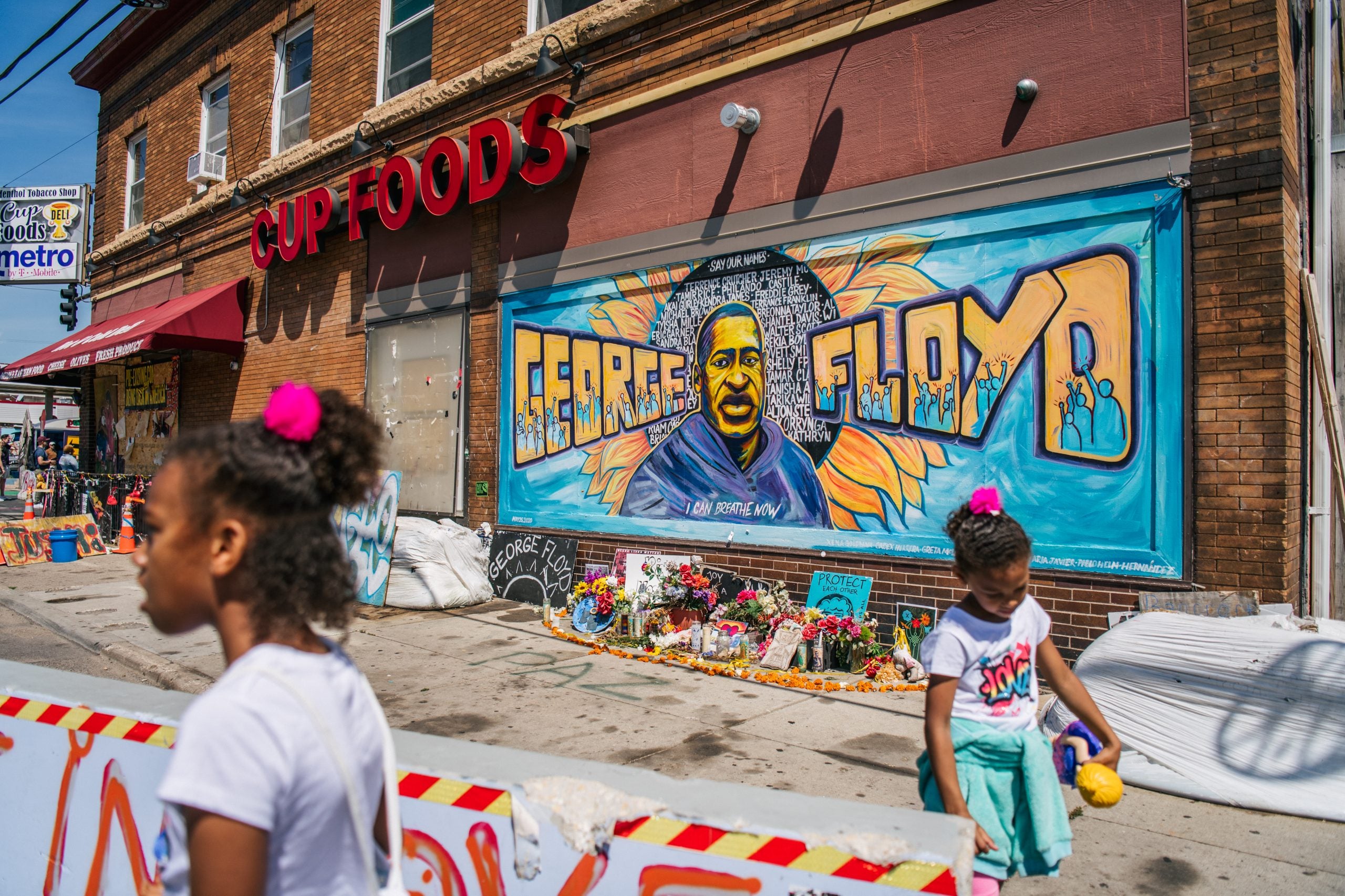
Today marks the second anniversary of the death of George Floyd. He would have been 48 years old had his life not been cut short by Minneapolis police officers. Floyd was pinned facedown with Officer Thomas Lane holding down Floyd’s legs, Officer J. Alexander Keung holding down Floyd’s torso, as Officer Derek Chauvin kept his knee on Mr. Floyd’s neck for nine and a half minutes. Officer Tou Thao stood nearby and kept a crowd of upset bystanders back as Floyd desperately pleaded for them to let him breathe. A completely disproportional response to the alleged crime of using a counterfeit $20 bill to purchase some cigarettes as accused by a suspicious store clerk.
Seventeen-year-old Darnella Frazier bravely recorded the murder using her cell phone camera and subsequently posted the footage on Facebook. Floyd might “have been yet another Black man to die in police custody – a statistic; instead, George Floyd became a powerful symbol of persistent inequality and systemic injustice against Black Americans.”
The video of Floyd’s murder, where he called out to his mother in his final moments, became the “cry heard ‘round the world” akin to Mamie Elizabeth Till-Mobley’s decision to hold an open casket at her son Emmett’s funeral. Thousands took to the streets across the country, protesting and marching, calling “for an end to racism and police brutality against people of color.”
As the country wrestled with a racial reckoning, many were optimistic that change was finally on the horizon for Black America. Unfortunately, not much has changed in the two years since Floyd’s murder.
President of the National Urban League Marc Morial said, “There’s a backlash that’s being fueled. It’s the replacement theory backlash. It’s the anti-CRT [critical race theory] backlash. It’s the Jan. 6 backlash.” Last week’s mass shooting in a predominantly Black neighborhood in Buffalo, NY, confirms that it is still dangerous for Black people in America to live their lives and even perform mundane tasks such as grocery shopping.
As we celebrate Floyd’s legacy, ESSENCE reports on what has fundamentally changed since May 2020.
Two years ago, a hopeful Joe Biden campaigning to become the next President of the United States, “addressed the nation, speaking passionately about police reforms that he stressed could not wait another month, let alone another election cycle: banning police chokeholds; rules for the use of force; a review of every police department’s hiring, training and de-escalation practices.”
Today, President Biden will sign a long-awaited police reform executive order that “will establish a national police registry for officers fired due to misconduct and requires that all federal law enforcement agencies regularly submit records such as substantiated complaints and disciplinary actions to the database.” The action also requires federal agencies to investigate incidents involving use of deadly force thoroughly. It also bans federal law enforcement officers from using chokeholds and so-called carotid restraints unless deadly force is authorized. And it includes new tools to screen and vet officers and require them to intervene to stop the use of excessive force when they see it, and that they administer medical aid to injured people,” according to Politico.
Commenting on the executive action, the Fraternal Order of Police’s executive director Jim Pasco said, “We all came at it in the beginning from very different perspectives…While it may not be totally pleasing to everyone, it addresses many of the concerns and areas of interest on the part of the civil rights community and also on the part of the police community.”
At the federal legislative level, “the George Floyd Justice in Policing Act passed the House twice, only to be rebuffed by Senate Republicans,” while the BREATHE Act championed by Congressional Representatives Rashida Tlaib and Ayanna Pressley, still awaits a House introduction.
At the federal legislative level, “the George Floyd Justice in Policing Act passed the House twice, only to be rebuffed by Senate Republicans” while the BREATHE Act championed by Congressional Representatives Rashida Tlaib and Ayanna Pressley, still awaits a House introduction.
U.S. Representative James Clyburn, the House Majority Whip, has voiced his frustrations with the stalled legislative efforts, saying “I don’t see this as a Democratic problem versus a Republican problem. I don’t see it as a Black problem versus white problem…We have a national problem here. This is a problem for all Americans.”
Derrick Johnson, President of the NAACP, has likened the current status of policymaking to that of the Civil Rights Act, “Policy change is slow. It is not [instantaneous]. And even though individuals come to the table with the most righteous approaches to what policy should be in place, oftentimes it is not something that happened overnight or in this case even in two years. There is a process.”
Indeed, there has been some progress since May of 2020 regarding police reform. Last year, the New York Times analyzed “data from the National Conference of State Legislatures” and found that more than 30 states have passed over 140 police reform and oversight laws:
- 4 states now limit officer immunity
- 10 states now mandate or fund body cameras
- 16 states now restrict neck restraints
- 5 states now restrict no-knock warrants
These steps are a positive indicator, however, police reform advocates criticize how the majority of the policies that states and cities are adopting focus on “the use of force or accountability after the fact.”
Additionally, there were attempts to acknowledge the racism that often occurs in this country; for instance, fifty of the biggest U.S. “companies pledged at least $49.5 bn to address racial inequality…The US government declared a new federal holiday to commemorate the emancipation of enslaved people, and officials worldwide took symbolic steps to show a renewed commitment to eliminating racism and the vestiges of past wrongs,” nevertheless, whereas symbolic steps are a good first move, two years later much of the early allyship that occurred now seems largely performative, especially if you remember the Black squares on Instagram.
Meanwhile, on the ground where it all began “many Black Minneapolis residents say little has changed since Floyd’s killing,” as signs featuring Floyd’s likeness and Black Lives Matter have disappeared from front yards, even while lingering racial tensions remain.
“Although everybody’s heart seems to be in the right place, their actions are not matching up as fast…We’re dealing with big, deep cultural issues, systematic issues that have built up for hundreds of years and that takes time…You worry about the time that it is taking and whether we are missing a moment,” said PJ Hill, vice-chair of the Minneapolis NAACP.
Some justice was served for Floyd when his killer, Officer Chauvin, received a guilty verdict at trial, and is now serving a 22½ year murder sentence in prison, and the other three officers at the scene “were convicted in February on federal civil rights charges related to Floyd’s death.”
A recent report reveals that since Floyd, the Minneapolis Police Department has killed 14 people, 13 of which “were people of color or Indigenous” including Amir Locke who “was killed as officers executed a no-knock warrant inside a downtown Minneapolis apartment in February,” in an eerily similar scenario to Breonna Taylor’s fatal shooting. To this day the department remains plagued by accusations of discriminatory policing.
Local advocate Marcia Howard has maintained a near-constant presence at George Floyd Square in the past two years, “leading a protest occupation of about a dozen people who keep the area tidy and watch for trouble. Her group met recently to discuss how they’ll welcome the throngs of visitors expected for anniversary events, starting with Wednesday’s candlelight vigil.” Although elected officials in Minneapolis would like to erect a permanent memorial in honor of Floyd in conjunction with the work being done to upgrade the city’s public transportation system and repave the streets, Howard “vows not to let that happen until there’s a substantive change in how police treat people of color. ‘The only thing that seems to change anything in the city of Minneapolis is collective action. We’re not burning down Lake Street. We’re not walking down University Avenue,’ Howard said. ‘We’re standing in place, in situ, where a Black man was lynched in public. And we’re saying we’re not moving.’”
In Houston, where Floyd grew up, a statue “will be unveiled Wednesday at Tom Bass Regional Park Section III…County and city leaders, including Harris County Commissioner Rodney Ellis, Houston Mayor Sylvester Turner, and Harris County Judge Lina Hidalgo, will join Floyd’s family members to reveal the ‘Conversation with George’ Statue at the park’s community center.” The sculpture will portray Floyd sitting down at an outdoor table, “‘welcoming everyone – all races and ethnic backgrounds – to have a seat and join him’…[and] the Floyd Family Foundation was involved and approved the sculpture” per a press release.
The summer of 2020 after Floyd’s murder also saw an uptick in street art, which provided hope and inspiration to many, precipitating the production of a “tempting tableau of a country strewn with canvases.” But as the energy around the great “racial reckoning” has waned, so has the art. In fact, a New York Times think piece has coined the phenomenon: “[t]he Great Erasure is underway, not so much an attempt to erase the uprising itself as an attempt to blunt its effects. There is no example of this erasure more striking than the continual destruction, removal, or slow vanishing of much of the street art produced in the wake of Floyd’s killing. According to a database compiled by three professors at University of St. Thomas in Minnesota — Heather Shirey, David Todd Lawrence and Paul Lorah — there were once approximately 2,700 murals, graffiti, stickers, posters affixed to surfaces and light projections created in response to Floyd’s killing, mostly in the Twin Cities of Minneapolis and St. Paul. Shirey and Lawrence called it ‘the largest proliferation of street art around one idea or issue or event in history.’ But many of those pieces have disappeared, sometimes because of exposure to traffic or the elements and sometimes because of deliberate attempts to erase them. Business owners quietly removed the graffitied planks from their storefronts. Some of the murals have been defaced.”







Though much of the news cycle today will focus on Floyd’s death, The Guardian examined what Floyd’s life might “have looked like without the crushing weight of racism.” Even though Floyd has become a household name, it is important to remember his humanity, and what he meant to those in his life as a son, a father, a boyfriend. The article reads, “Remembering Floyd’s story hopefully reminds us what can happen to an individual when a society ignores the residue of historically racist policies, while teaching us about having persistence in the face of challenges…Instead of being born impoverished, Floyd could have come into the world as a wealthy scion of an industrious great-great-grandfather, if racism had not stripped his hardworking ancestors of their landholdings in North Carolina at the turn of the 20th century. He could have been able to pursue his second-grade dream of ascending to the Supreme Court, if underfunded public schools and dilapidated public housing had not defined his adolescence in a segregated slum. His lyricism and poetic nature could have elevated him to prominence in the world of arts if his struggles with addiction and mental illness had been met with treatment rather than the unforgiving cruelty of the U.S.’s mass incarceration complex. His less ambitious goals later in life – to become a truck driver or to open a small restaurant and provide jobs for the downtrodden – could have been achievable if Derek Chauvin had not ignored his pleas for mercy on that fateful day two years ago.”
For those who want to learn more about Floyd’s life, they can turn to a newly published biography that provides insight into the man behind the hashtag, His Name Is George Floyd One Man’s Life And The Struggle For Racial Justice, written by Robert Samuels and Toluse Olorunnipa. The two authors hope to change the narrative as “[m]any don’t know how he lived – that he habitually told friends that he loved them, often in all-caps text messages; that he was self-conscious about his 6-foot-6-inch frame and that he suffered from lifelong claustrophobia; that he and his roommate in Minneapolis moved their mattresses into the living room right next to each other.”






